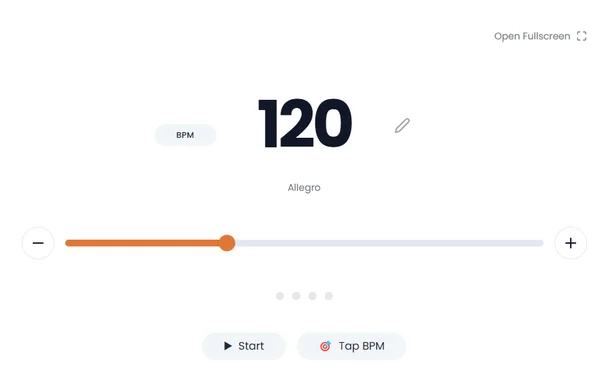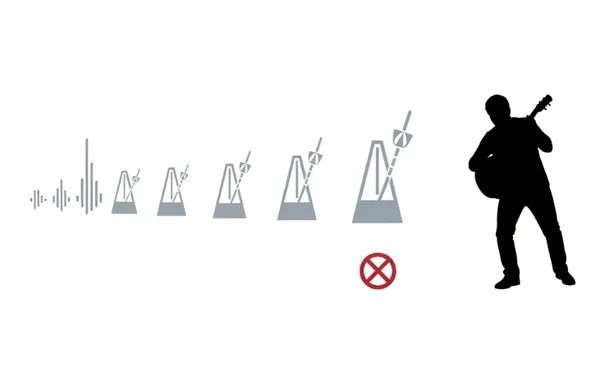Develop Rhythm Sense: From Metronome to Internal Clock
Do you ever wonder how to feel the beat without a metronome constantly guiding you? Many musicians strive to develop rhythm sense to a point where their internal clock is so finely tuned that they achieve true metronome independence. This isn't about abandoning your trusty metronome; it's about using it strategically to cultivate an inner pulse that allows for more expressive and confident playing. Let's explore how your metronome practice, especially with a versatile online metronome like our free tool here, can lead you to this level of rhythmic freedom.
I. Introduction: The Goal of Metronome Practice – To Feel the Beat Within
What is the ultimate aim of diligent metronome practice? Is it simply to play perfectly in time with an external click indefinitely? While timing accuracy is a crucial starting point, the deeper goal for most musicians is to internalize rhythm – to cultivate a reliable internal clock that allows them to feel the beat intuitively and maintain a steady tempo even when the click stops. This journey towards metronome independence is about transforming the metronome from a crutch into a powerful training tool. A free metronome, accessible and easy to use like the one you can find on our site, is your perfect partner in this endeavor.

II. Understanding Your Internal Clock: What is True Rhythm Sense?
Before we dive into exercises, it's important to understand what we mean by internal clock and true rhythm sense. How to develop internal rhythm? It begins with grasping these concepts.
More Than Just Keeping Time: The Nuances of Rhythmic Feel
True rhythm sense goes beyond merely hitting notes at the correct beats per minute. It encompasses an understanding of groove, subdivision, swing, and the subtle push and pull that gives music its musicality and life. It’s about how you feel the beat, not just count it. This natural rhythm practice aims to improve rhythm sense at a fundamental level.
Why Some Musicians Naturally Feel the Beat (And How You Can Too)
While some individuals may seem to have an innate gift for rhythm, a strong internal clock is a skill that can be developed through consistent and intelligent metronome practice. It's less about "talent" and more about focused effort and the right rhythm exercises.
The Dangers of Over-Reliance on Your Online Metronome
Is it bad to always practice with an online metronome? If used passively, without the intention to internalize rhythm, an online metronome can become a "metronome crutch." This can lead to playing that sounds mechanical or a loss of confidence when the click is removed. The goal is to stop relying on metronome as a constant necessity.
III. The Metronome's Role: A Tool, Not a Crutch, for Rhythm Development
How can you use an online metronome effectively to develop rhythm sense rather than dependence? The key is to view it as a diagnostic and training partner.
How Your Online Metronome Builds a Solid Rhythmic Foundation
A quality free metronome, such as our online metronome tool, provides an unwavering, objective reference for tempo and beat placement. This is essential for building initial timing accuracy. Consistent metronome practice with clear metronome settings helps to etch precise rhythmic patterns into your muscle memory and auditory processing.

Using Metronome Settings to Challenge and Develop Your Internal Clock
Don't just passively play along. Use the features of your online metronome to actively challenge your internal clock. For instance, with our versatile online tool, you can experiment with:
- Subdivisions: Practice with the metronome clicking quarter notes, but you play or count eighths or sixteenths.
- Accent Variations: If your metronome allows, shift accents to unexpected beats.
- Tempo Changes: Practice maintaining stability through gradual tempo increases or decreases. These rhythm exercises actively engage your brain in the process to internalize rhythm.
Recognizing When It's Time to Reduce Metronome Dependence
Some signs that you're ready to work towards metronome independence include:
- You can maintain a steady tempo for a short period if the metronome unexpectedly stops.
- You start to feel the beat internally rather than just reacting to the click.
- Your playing feels more locked-in with the metronome, even at very soft volumes.
IV. Exercises to Develop Rhythm Sense & Achieve Metronome Independence
What are the best exercises for metronome independence? Here are some proven techniques you can implement with your online metronome.
The "Fade Out" Technique: Gradually Removing the Click
This is a fantastic way to stop relying on metronome gradually.
-
Start your metronome practice with the click from our easy-to-use metronome at a comfortable volume.
-
After a few minutes, gradually decrease the metronome's volume until it's barely audible, then silent, while you continue playing.
-
After a set period (e.g., 16 bars), bring the volume back up to check your timing accuracy. This natural rhythm practice forces your internal clock to take over.

"Silent Bar" Practice: Testing Your Internal Clock Stability
- Set your online metronome to play for a certain number of bars (e.g., 4 bars) and then be silent for the same number of bars. You can try this with our tool.
- Your goal is to continue playing or counting accurately through the silent bars and land perfectly when the click returns. This is a direct test and training method to develop rhythm sense.
Playing Along with Recordings: Syncing with Human Grooves
While not a direct online metronome exercise, this is crucial for developing musicality.
- Choose a recording with a strong, clear rhythm section.
- Use the tap tempo feature, like the one available when you access our metronome, to find the song's beats per minute.
- First, play along with the recording AND your online metronome set to that BPM to ensure you're locked in.
- Then, try playing with just the recording, focusing on syncing with the human groove and rhythmic feel.
Body Movement and Vocalization: Connecting Rhythm to Your Physicality
Engaging your body helps internalize rhythm.
-
Tap your foot, nod your head, or even conduct lightly while practicing with your free metronome.
-
Vocalize the beats or subdivisions (e.g., "1-e-&-a, 2-e-&-a"). This multi-sensory approach strengthens your internal clock.

V. Beyond the Metronome: Living and Breathing Rhythm Naturally
Achieving metronome independence is a significant milestone. How do I know if my internal clock is improving?
Recognizing the Signs of a Developed Internal Rhythm Sense
You'll start to notice:
- Your playing feels more grounded and confident, even without a click.
- You can feel the beat consistently in different musical situations.
- You lock in with other musicians more easily.
- Your timing accuracy remains solid over longer passages.
Maintaining Your Rhythmic Skills Without Constant Metronome Use
Even with a strong internal clock, occasional check-ins with your online metronome are beneficial, like a tune-up for your car. But it's no longer a constant guide.
The Joy of True Metronome Independence and Musical Freedom
The ultimate reward is the freedom to express yourself musically without being tethered to an external click, allowing your natural rhythmic feel and musicality to shine.
VI. Your Journey to Mastering Your Internal Clock Starts Now
Developing a robust internal clock and achieving metronome independence is a process that requires patience and smart metronome practice. By using tools like the free metronome available when you visit our website strategically, you can transform your relationship with rhythm. Start implementing these rhythm exercises today, and you'll be well on your way to truly internalizing the beat.
What are your biggest challenges in trying to develop rhythm sense? Share your thoughts or questions in the comments below!
VII. Developing Your Rhythm Sense and Internal Clock
-
Is it bad to always practice with an online metronome?
Not if your goal is to actively develop rhythm sense and work towards metronome independence. However, if you only play reactively to the click without trying to internalize rhythm, it can hinder the development of your internal clock. Using a free metronome like the one we offer for focused exercises is key.
-
What are the best exercises for metronome independence?
The "Fade Out" technique and "Silent Bar" practice, as described above, are excellent. Also, consistently checking your timing by recording yourself playing without a metronome and then analyzing it with the tap tempo feature of an online metronome, such as the one you can use on our platform, can be very insightful.
-
How do I know if my internal clock is improving?
You'll notice increased timing accuracy when playing without a metronome, a better ability to feel the beat in ensemble situations, and more confidence in your rhythmic placement. You'll also find yourself relying less on the visual or auditory cues of the online metronome.
-
Can a free metronome help develop rhythm sense?
Absolutely! A free metronome like the one available at metronomeonline.org provides all the essential features (adjustable tempo, time signatures, clear click) needed for effective metronome practice to build your internal clock and improve rhythm sense.